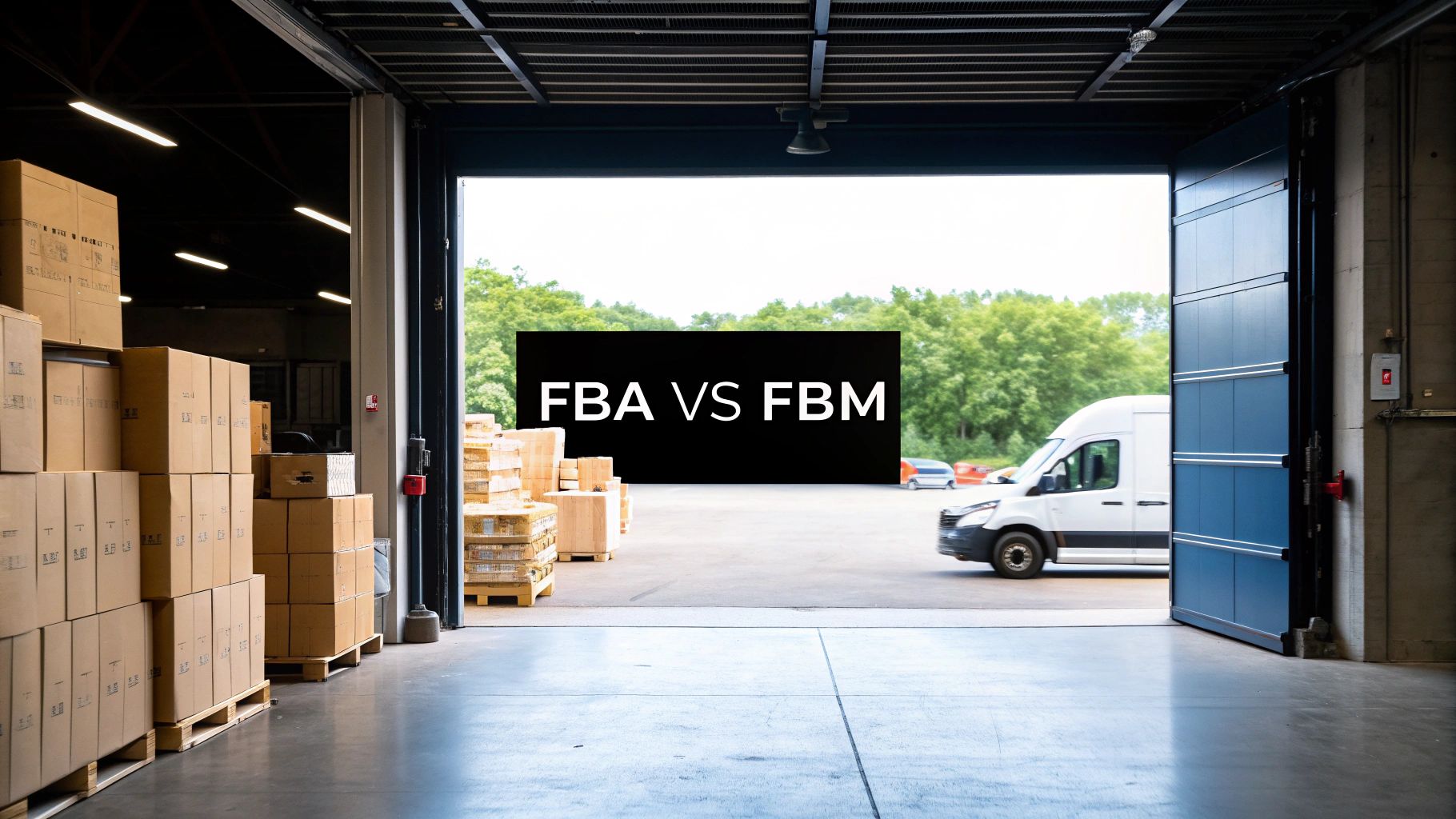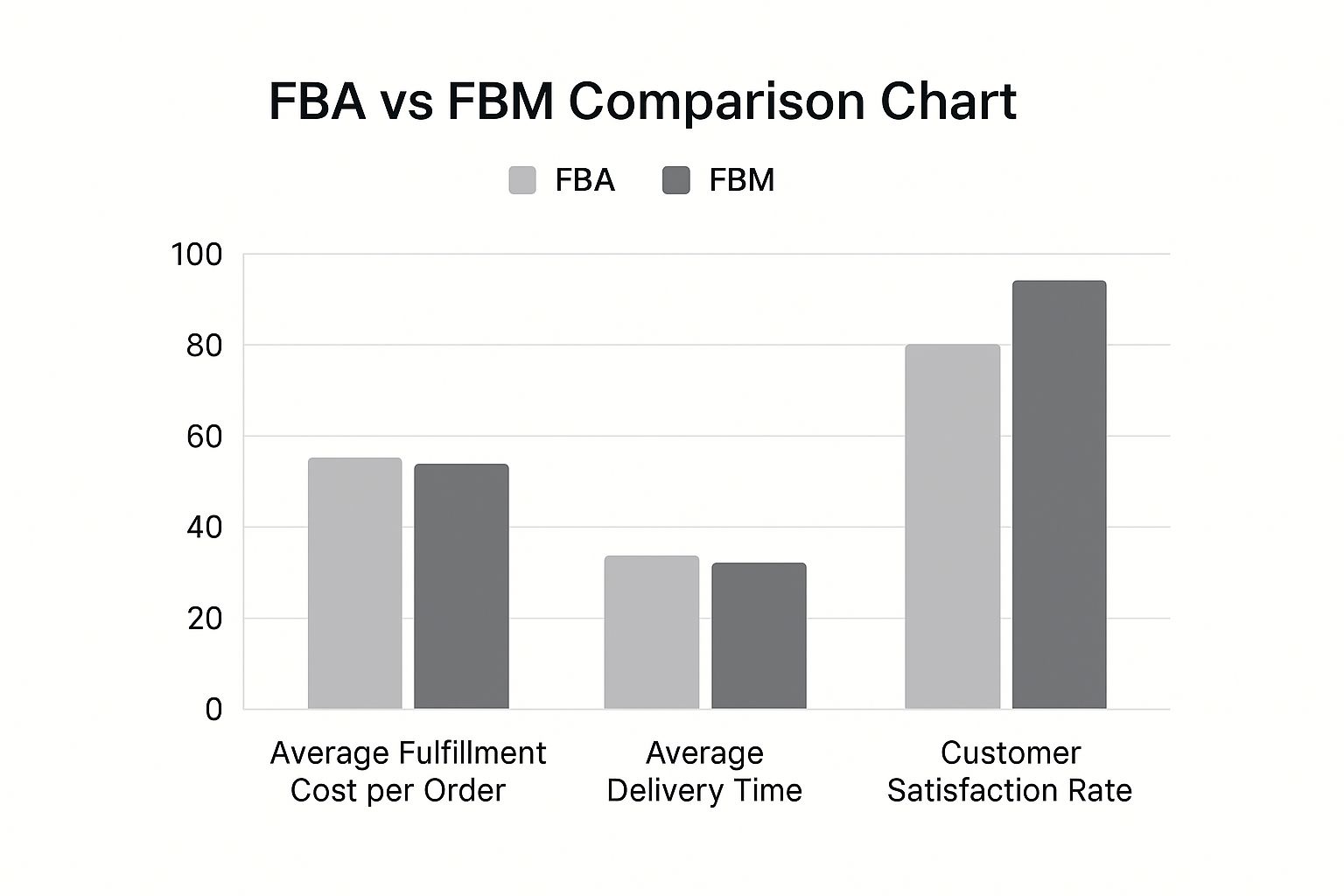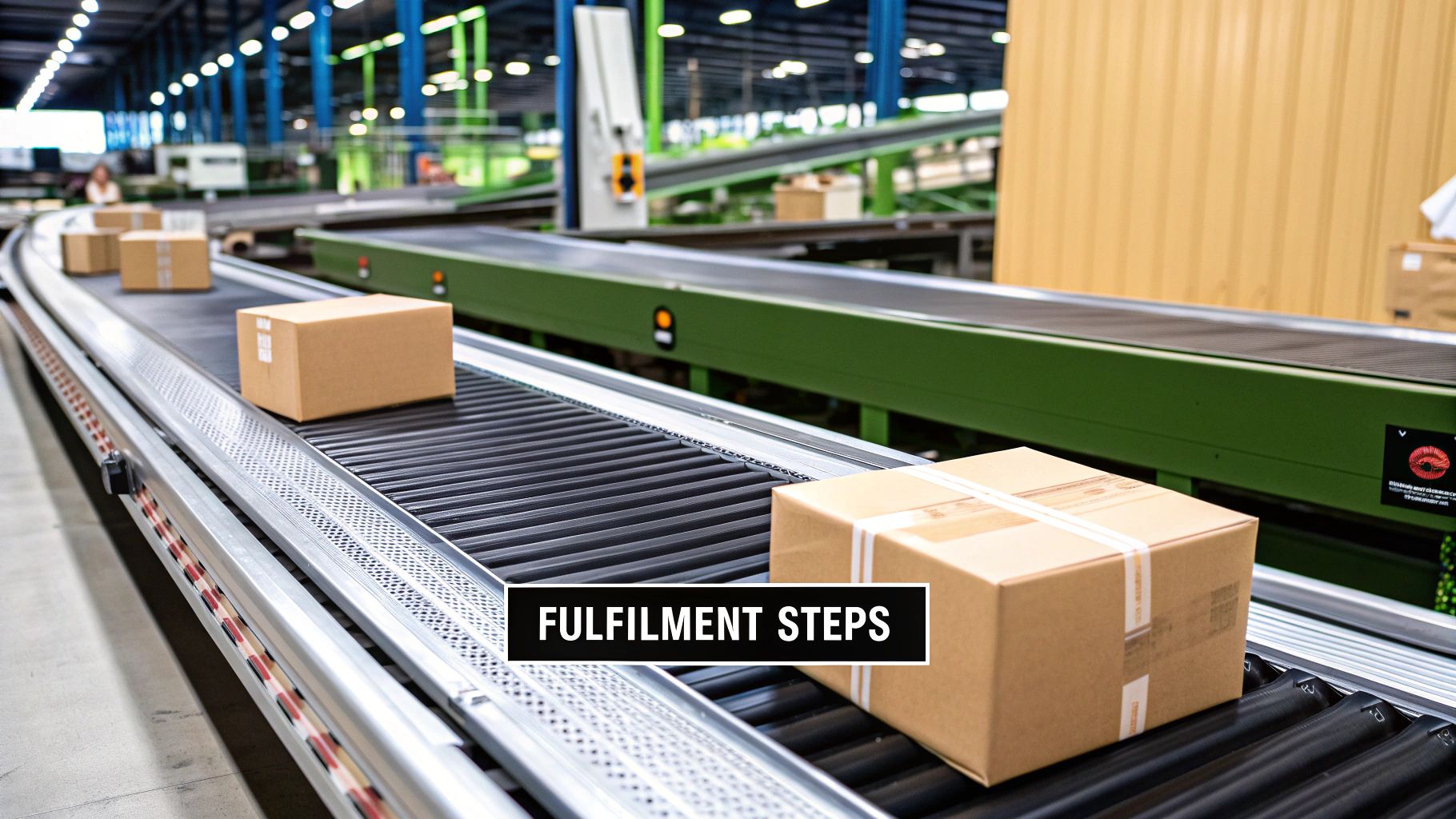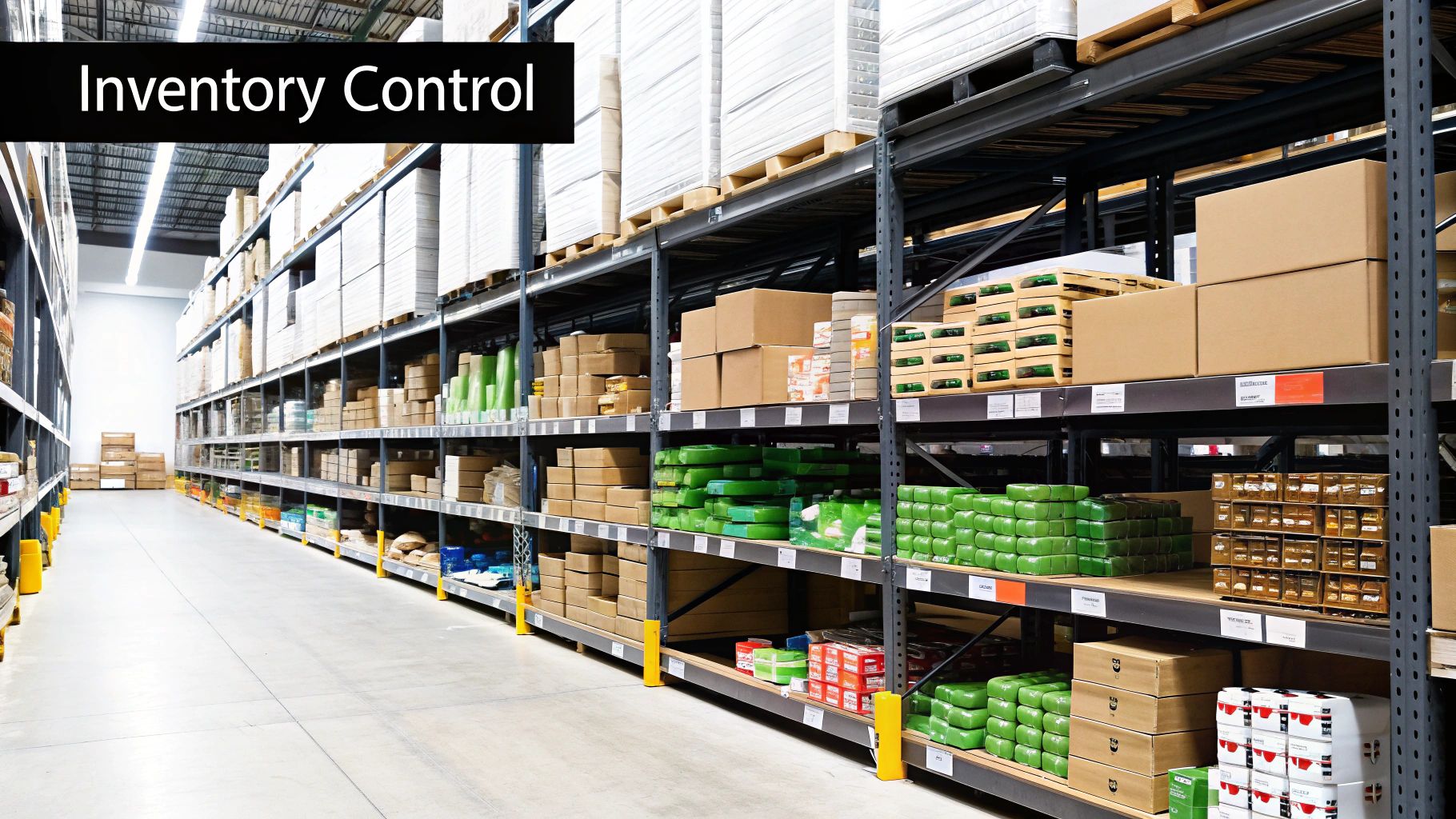Stay Updated with Everything about MDS
Thank you! Your submission has been received!
Oops! Something went wrong while submitting the form.

Chilat Doina
August 14, 2025
Choosing between Fulfillment by Amazon (FBA) and Fulfillment by Merchant (FBM) really boils down to a simple trade-off. Fulfillment by Amazon (FBA) is for sellers who want convenience, scalability, and that all-important Prime badge, letting Amazon handle the heavy lifting. On the other hand, Fulfillment by Merchant (FBM) is for sellers who need total control over their inventory, branding, and how they talk to customers.
Your final decision hinges entirely on what you're selling, your business model, and how fast you want to grow.
Getting your fulfillment strategy right from the start is a massive decision. It directly impacts your profits, your daily workload, and your ability to scale. FBA gives you a hands-off approach that’s incredibly appealing, but it comes with a specific fee structure and you lose some control. FBM offers more freedom and potentially better margins, but suddenly you're the one managing the entire logistics chain.
To make sense of it all, let’s start with a high-level look at the core differences between these two powerful fulfillment models.
This table gives you the basics, but the real story is in the day-to-day operations and what each model demands from you as a seller.
The table above is a good starting point, but the reality on the ground is far more nuanced. FBA is a well-oiled machine built for massive efficiency. You prep your products to meet Amazon's strict rules, ship them to their fulfillment centers, and they handle the rest. It's the perfect path if you'd rather focus on sourcing and marketing instead of running a warehouse. To make life even easier, you can explore specialized tools for Amazon FBA sellers to help you track inventory and nail down your profitability.
FBM, however, puts you squarely in the driver's seat. It's the go-to model for businesses with specific needs, like:
As you set up your Amazon business, don't forget the essentials. Beyond picking a fulfillment method, it's critical to understand the fundamentals of protecting your company with the right coverage. A solid grasp of business insurance basics is non-negotiable.

The data here is pretty clear. While FBA might have higher direct costs, it dominates in delivery speed and customer satisfaction—two of the most powerful factors in winning the Buy Box and driving sales.

To really get what Fulfillment by Amazon (FBA) is about, you have to look past the basic definition. Think of it less as a service and more as plugging your business directly into Amazon’s massive, time-tested logistics network. You’re essentially handing off the most physically demanding parts of e-commerce so you can get back to growing your brand.
It all starts with you, the seller. Your first job is to get your products ready according to Amazon’s very specific rules. This is more than just throwing items into a box. It involves precise labeling, packaging, and sorting to make sure your inventory slots perfectly into Amazon's automated system. After everything is prepped, you’ll set up a shipping plan in Seller Central and send your products off to the fulfillment centers Amazon assigns you.
Once your shipment hits their loading dock, Amazon’s machine takes over. This is where the magic of FBA happens. Your products get scanned, sorted, and stored inside a sprawling warehouse system, just waiting for a customer to click "Buy Now."
The moment a customer orders your FBA product, a complex, automated process sparks to life—all without you lifting a finger. Amazon’s system finds your item in the warehouse, and an employee (or often, a robot) picks it off the shelf.
From there, the item is professionally packed into an Amazon-branded box, complete with any necessary padding to keep it safe. Amazon then ships the order straight to the customer, tapping into its own delivery network or partner carriers to hit that Prime delivery window. For many customers, that means getting their package the very next day.
This completely hands-off process is why FBA is so incredibly popular. The numbers don't lie. By 2025, it's projected that around 82% of Amazon sellers will be using FBA. This huge adoption rate is directly tied to the power of Amazon Prime, a perk that millions of shoppers now consider essential. You can dive deeper into FBA's market dominance on Red Stag Fulfillment.
The whole cycle, from picking the product to final delivery, is handled by Amazon. They also manage all the customer service that goes with it, like answering shipping questions, providing tracking info, and processing returns.
Key Insight: With FBA, you’re not just outsourcing shipping; you're outsourcing your entire back-end operation. This frees you up to focus on what actually grows your business: sourcing great products, marketing, and building a brand.
While FBA automates the heavy lifting, your job evolves into a strategic one: managing your inventory. You have to keep a close eye on your stock levels in Seller Central. If you run out of stock, your sales velocity plummets, and so does your search ranking.
On the flip side, you can't just send in a mountain of inventory and forget about it. Amazon charges monthly and long-term storage fees based on how much space your products take up. Letting slow-moving inventory sit there can eat away at your profits.
Ultimately, the Amazon FBA vs FBM decision often hinges on this very trade-off. FBA gives you an unmatched engine to scale your sales and reach millions of loyal Prime members. It lets you skip the massive headache and expense of building your own warehouse operation. But that convenience comes at a price—both in fees and in a loss of direct control. To make it work, you have to be diligent about managing your inventory and fees to keep your business profitable.

While FBA offers a mostly hands-off approach to getting your products to customers, Fulfillment by Merchant (FBM) puts you squarely in the driver's seat. Choosing FBM means you’re taking full command of your own fulfillment operations.
This model is a strategic move for sellers who value control, brand customization, and direct customer interaction above all else. With FBM, you are responsible for the entire fulfillment journey, a stark contrast to the outsourced nature of FBA. It's more work, yes, but for many businesses, that level of control isn't just a perk—it’s a powerful competitive advantage.
One of the biggest draws of FBM is the ability to shape the entire customer experience. You're no longer stuck with a generic, Amazon-branded box. Instead, you can use custom packaging that screams your brand, slip in personalized thank-you notes, or include marketing inserts that drive repeat business.
That direct touchpoint is pure gold for building brand loyalty. It lets you create a memorable unboxing experience that FBA simply can’t match, which is especially critical for premium or artisan brands where presentation is a huge part of the product's value.
Beyond branding, FBM offers incredible inventory flexibility. Your stock isn't scattered and locked away in Amazon's massive warehouse network; it's right where you can access it. This is a total game-changer for multi-channel sellers who need to pull from a single inventory pool to fulfill orders from their own website, other marketplaces like Etsy or eBay, and even physical retail stores. You get real-time control over your stock levels, which helps prevent those dreaded stockouts and overselling headaches.
This hands-on model is a perfect fit for a few specific product types:
For high-performing FBM sellers, there’s a path to earning the coveted Prime badge without ever touching an FBA warehouse: Seller Fulfilled Prime (SFP). But be warned, getting into and staying in the SFP program is incredibly tough. Amazon holds SFP sellers to the exact same strict delivery promises as FBA, meaning you have to fund one-day and two-day shipping all on your own.
Important Note: The Seller Fulfilled Prime program has always had a very high bar for entry and is frequently closed to new applicants. To even be considered, sellers must prove near-perfect fulfillment metrics, including an on-time shipment rate of over 99% and consistent use of approved carriers. It's an elite status that very few can achieve and maintain.
Ultimately, the choice between Amazon FBA vs FBM boils down to your core business priorities. If your strategy is built on strong brand equity, multi-channel sales, or selling unique products that just don't fit the FBA mold, the control and flexibility of FBM are absolutely indispensable.
Profitability on Amazon isn't just about how much you sell; it's about how well you control your costs. When you’re weighing FBA against FBM, you have to look past the obvious fees and dig into every single expense, both direct and indirect, to figure out your true profit margin.
At first glance, FBA looks pretty straightforward, if a bit complex. You're essentially paying for convenience—letting Amazon handle all the heavy lifting of logistics. The main costs you'll see are fulfillment fees (what it costs Amazon to pick, pack, and ship your product) and monthly storage fees (the "rent" for your inventory sitting in an Amazon fulfillment center).
But the financial landscape has gotten a lot more complicated. Starting in 2025, Amazon rolled out fee increases and new charges, like the low-inventory-level fee. This fee penalizes sellers who don't keep enough stock relative to their sales, making FBA a pricier option, especially for products with slim margins or those that don't fly off the shelves. For slow-movers, storage costs alone can eat your profits alive. You can learn more about these recent FBA fee changes at SellerLabs.com.
If you want to accurately forecast your FBA profitability, you need to budget for a whole host of potential fees. These aren't optional, and they can seriously dent your bottom line if you're not paying attention.
Choosing Fulfillment by Merchant (FBM) lets you sidestep most of Amazon’s direct fulfillment and storage fees, which looks like a huge win on paper. But you’re not really eliminating those costs—you’re just taking them on yourself. The real question is: can you do it cheaper than Amazon?
Your FBM cost structure is an entirely different beast:
The most common mistake new sellers make is underestimating FBM’s operational costs. The money saved on Amazon fees is directly transferred to your own operational budget for labor, materials, and shipping. A profitable FBM business is one that can perform these tasks more cost-effectively than Amazon.
To really wrap your head around the financial differences, it helps to see the cost structures laid out side-by-side. This table breaks down where your money goes with each model, making the FBA vs. FBM trade-offs crystal clear.
Ultimately, there’s no one-size-fits-all answer. The right choice comes down to running the numbers for your specific products. Many veteran sellers land on a hybrid approach, using FBA for their bestsellers and FBM for everything else. To get more insights on building a winning strategy, check out our guide for successful Amazon FBA sellers.

When you're weighing FBA vs. FBM, the conversation always lands on one massive, game-changing factor: the Amazon Prime badge. This isn't just a little logo next to your listing. It's a powerful symbol of trust and speed that fundamentally changes how customers shop.
Choosing Fulfillment by Amazon (FBA) is the most straightforward way to get that coveted badge on your products. It’s an instant ticket into Amazon's most valuable customer ecosystem. Prime members aren't just casual buyers; they're a loyal, high-spending group who have been trained to filter for Prime-eligible products and expect fast, free shipping as a given.
This automatic eligibility is FBA's killer app. With FBA, your products are instantly put in front of over 150 million Prime members worldwide (as of 2025). Giving customers the fast, free shipping they demand directly translates into better visibility, more shopper trust, and, most importantly, higher conversion rates. For a deeper dive, check out how Prime impacts sellers on myamazonguy.com.
That little Prime badge is a powerful psychological shortcut. It immediately answers the two biggest questions on a shopper's mind: "When will I get it?" and "How much is shipping?" By giving them a fast and free answer, you remove huge barriers to making a purchase.
Think about the direct impact:
Key Takeaway: The Prime badge is more than a shipping perk; it’s a built-in trust signal. It tells customers that Amazon is backing the delivery, which can easily be the deciding factor between you and an FBM competitor.
For sellers using Fulfillment by Merchant (FBM), getting that Prime badge is a whole different story. It’s a monumental challenge. By default, most FBM products don't have it, which puts them at an immediate disadvantage. They get filtered out of search and often have to compete on price alone—a race to the bottom that can absolutely crush your profit margins.
The only way for an FBM seller to earn the badge is through the Seller Fulfilled Prime (SFP) program. But let's be honest, the performance standards are so ridiculously high that the program is often closed to new applicants and is notoriously difficult to stay in.
SFP essentially demands that you provide FBA-level service, but on your own dime. This means:
For most sellers, the cost and operational headache of SFP just aren't worth it. This reality completely reframes the FBA vs. FBM decision. It stops being a simple logistics choice and becomes a strategic one about market access. FBA is, without a doubt, the most direct and reliable path to Amazon's best customers.
Figuring out whether to go with Amazon FBA or FBM isn't about finding a single "right" answer. Generic advice will only get you so far. The truth is, the best fulfillment method is tangled up in the specifics of your business—what you sell, how you operate, and where you want to go.
To really nail this decision, we need to get out of the weeds of theory and look at how things play out in the real world. Let's walk through four common seller types. See if you recognize your own business in one of these profiles.
Picture a seller who's moving a ton of popular, standard-sized products. Think phone cases, resistance bands, or water bottles. Sales are consistent and fast, with hundreds of units flying off the shelves every week. For this kind of operation, FBA is the undisputed champion.
Trying to manage that kind of volume with FBM would be an absolute logistical nightmare. You'd quickly find yourself needing a dedicated team just for picking, packing, and shipping, not to mention a serious amount of warehouse space. FBA takes all of that off your plate, freeing you up to focus on sourcing more inventory and marketing your brand to keep the momentum going.
Plus, the automatic Prime eligibility that comes with FBA is a game-changer. It gets your products in front of Amazon's most loyal customers and gives you a massive leg up in winning the Buy Box, which is essential for keeping those high sales numbers rolling in.
Now, let's flip the script. Imagine a small workshop that builds and sells beautiful, handcrafted coffee tables. These pieces are heavy, oversized, and need a lot of care during shipping. In this case, FBM isn't just the better choice—it's the only viable one.
Trying to use FBA for items like this would be financially ruinous. The storage fees for large products are sky-high, and the fulfillment fees for anything oversized would completely wipe out your profit margins. Even more critically, you lose all say in how your products are packaged. FBM lets the maker build custom crates to make sure their valuable work arrives in one piece, a level of detail Amazon's standardized system just can't match.
Key Takeaway: For products with unique needs—whether they're oversized, fragile, or require special handling—FBM gives you the control you need to protect your products and your brand's reputation. It turns fulfillment from a simple cost into a part of the customer experience.
What about a brand that's selling everywhere? They have their own Shopify store, a shop on Etsy, and they also list their products on Amazon. The biggest headache for them is keeping one unified inventory to avoid overselling. For this kind of seller, FBM provides the flexibility they need to survive.
If this retailer went all-in on FBA, a huge chunk of their inventory would be trapped in Amazon's fulfillment centers, making it impossible to sell those units on their own website. This creates a massive operational mess, often forcing them to use complex software or make constant manual adjustments just to keep stock levels accurate.
With FBM, all their inventory sits in one central spot, whether it's a small backroom warehouse or a dedicated third-party logistics (3PL) partner's facility. This single pool of stock can be used to fulfill orders from any channel, guaranteeing accurate inventory counts and a smooth workflow across their entire business.
Finally, let's think about someone who deals in rare, slow-moving collectibles—things like vintage comic books or limited-edition action figures. Sales might be few and far between, but each one comes with a hefty profit margin. For this dealer, FBM is the most cost-effective path forward.
The biggest killer for a business like this would be FBA's long-term storage fees. These items can sit on a shelf for months, sometimes even a year, before the right buyer comes along. The storage fees that pile up during that time could easily eat up all the profit from a sale. FBM completely sidesteps this problem. The seller can safely store their valuable, low-turnover items on their own property without getting hit with punishing fees from Amazon, making it the only sustainable way to run their business.
Once you’ve got the basics down, a few practical questions always pop up when you're weighing Amazon FBA vs FBM. Getting these details right is the difference between a smooth operation and a logistical headache. Let’s clear up some of the most common ones.
A big one sellers ask is if you can use both FBA and FBM for the same product. The answer is yes, you absolutely can. This is a smart hybrid strategy where you create two separate listings for a single ASIN—one fulfilled by Amazon, the other by you. It’s a fantastic way to keep sales rolling. If your FBA stock suddenly runs dry, your FBM offer can instantly pick up the slack, preventing a stockout and protecting your precious sales rank.
Your fulfillment choice directly and powerfully influences your shot at winning the Buy Box. There’s no sugarcoating it: FBA gives you a massive advantage in Amazon’s algorithm. The instant Prime eligibility and Amazon's own guaranteed shipping metrics are huge factors that Amazon prioritizes.
But that doesn't mean FBM sellers are out of the game. A top-tier FBM seller with a perfect Order Defect Rate, incredible shipping times, and sharp pricing can definitely win their share of the Buy Box. It just takes flawless execution on your end and, often, a more competitive price to stand out against FBA offers.
Key Insight: While FBA gives you a clear leg up for the Buy Box, exceptional FBM performance can absolutely bridge the gap. The real takeaway is that Amazon's algorithm rewards the best customer experience, regardless of whether it ships from their warehouse or yours.
A major risk you take on with FBA is dealing with inventory and restock limits. These are all governed by your Inventory Performance Index (IPI) score. Think of it as your FBA report card, graded from 0 to 1,000, that measures how well you manage your inventory. Amazon looks at your sell-through rate, how often you’re in stock, and whether you have excess or stranded inventory just sitting there.
If your IPI score falls below the threshold (which has historically been 400), Amazon can hit you with strict limits on how much inventory you can send in. This can completely choke your ability to restock your bestsellers, creating a huge operational bottleneck. For sellers looking to scale, digging into the FBA private market to buy and sell FBA businesses offers a masterclass in how established brands navigate these complex inventory hurdles.
At Million Dollar Sellers, we believe the best advice comes from people who are actually in the trenches, running their own successful businesses. Our private community is where elite e-commerce founders connect to share what’s working now and master the real-world challenges of scaling on Amazon. If you're ready to learn from the very best, see what it takes to join our network at https://milliondollarsellers.com.
Join the Ecom Entrepreneur Community for Vetted 7-9 Figure Ecommerce Founders
Learn MoreYou may also like:
Learn more about our special events!
Check Events